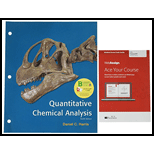
Concept explainers
(a)
Interpretation:
The voltage required to complete the given net reaction has to be calculated.
Concept Introduction:
When the
E(cathode) is electrode’s potential which is attached to negative terminal of current source.
E(anode) is electrode’s potential which is attached to positive terminal of current source.
Overpotential: The activation energy of a reaction at an electrode can be overcome by voltage. The required voltage to apply is called overpotential.
Ohmic potential: In
Concentration Polarization: It is the change in concentration of products and reactants at electrode’s surface unlike they are same in solution.
(a)
Answer to Problem 17.4P
The voltage required to complete the given net reaction is
Explanation of Solution
To determine: The voltage required to complete the given net reaction.
When the electric current is negligible, the voltage of net reaction is given as
(b)
Interpretation:
The ohmic potential which is voltage required to overcome the resistance of cell has to be calculated.
Concept Introduction:
Ohmic potential: In electrochemical cell, the electrical resistance of a solution while current I flows can be overcome by voltage. The required voltage to apply is called ohmic potential.
(b)
Answer to Problem 17.4P
The ohmic potential which is voltage required to overcome the resistance of cell is
Explanation of Solution
To determine: The ohmic potential which is voltage required to overcome the resistance of cell.
The ohmic potential of the cell is calculated as follows
(c)
Interpretation:
The voltage required to overcome the ohmic potential effect and
Concept Introduction:
When the electric current is too small, the voltage of cell is given as
E(cathode) is electrode’s potential which is attached to negative terminal of current source.
E(anode) is electrode’s potential which is attached to positive terminal of current source.
Overpotential: The activation energy of a reaction at an electrode can be overcome by voltage. The required voltage to apply is called overpotential.
Ohmic potential: In electrochemical cell, the electrical resistance of a solution while current I flows can be overcome by voltage. The required voltage to apply is called ohmic potential.
Concentration Polarization: It is the change in concentration of products and reactants at electrode’s surface unlike they are same in solution.
(c)
Answer to Problem 17.4P
The voltage required to overcome the ohmic potential effect and electrolysis effect is
Explanation of Solution
To determine: The voltage required to overcome the ohmic potential effect and electrolysis effect.
(d)
Interpretation:
The voltage required to overcome the ohmic potential effect and anodic reaction overpotential has to be calculated.
Concept Introduction:
When the electric current is too small, the voltage of cell is given as
E(cathode) is electrode’s potential which is attached to negative terminal of current source.
E(anode) is electrode’s potential which is attached to positive terminal of current source.
Overpotential: The activation energy of a reaction at an electrode can be overcome by voltage. The required voltage to apply is called overpotential.
Ohmic potential: In electrochemical cell, the electrical resistance of a solution while current I flows can be overcome by voltage. The required voltage to apply is called ohmic potential.
Concentration Polarization: It is the change in concentration of products and reactants at electrode’s surface unlike they are same in solution.
(d)
Answer to Problem 17.4P
The voltage required to overcome the ohmic potential effect and electrolysis effect is
Explanation of Solution
To determine: The voltage required to overcome the ohmic potential effect and anodic reaction overpotential.
From the anode voltage and cathode voltage, the voltage required to overcome the ohmic potential effect and anodic reaction overpotential is calculated as
Want to see more full solutions like this?
Chapter 17 Solutions
QUANTIT.CHEM..(LL)-W/WEBASSIGN(6 MONTH)
 ChemistryChemistryISBN:9781305957404Author:Steven S. Zumdahl, Susan A. Zumdahl, Donald J. DeCostePublisher:Cengage Learning
ChemistryChemistryISBN:9781305957404Author:Steven S. Zumdahl, Susan A. Zumdahl, Donald J. DeCostePublisher:Cengage Learning ChemistryChemistryISBN:9781259911156Author:Raymond Chang Dr., Jason Overby ProfessorPublisher:McGraw-Hill Education
ChemistryChemistryISBN:9781259911156Author:Raymond Chang Dr., Jason Overby ProfessorPublisher:McGraw-Hill Education Principles of Instrumental AnalysisChemistryISBN:9781305577213Author:Douglas A. Skoog, F. James Holler, Stanley R. CrouchPublisher:Cengage Learning
Principles of Instrumental AnalysisChemistryISBN:9781305577213Author:Douglas A. Skoog, F. James Holler, Stanley R. CrouchPublisher:Cengage Learning Organic ChemistryChemistryISBN:9780078021558Author:Janice Gorzynski Smith Dr.Publisher:McGraw-Hill Education
Organic ChemistryChemistryISBN:9780078021558Author:Janice Gorzynski Smith Dr.Publisher:McGraw-Hill Education Chemistry: Principles and ReactionsChemistryISBN:9781305079373Author:William L. Masterton, Cecile N. HurleyPublisher:Cengage Learning
Chemistry: Principles and ReactionsChemistryISBN:9781305079373Author:William L. Masterton, Cecile N. HurleyPublisher:Cengage Learning Elementary Principles of Chemical Processes, Bind...ChemistryISBN:9781118431221Author:Richard M. Felder, Ronald W. Rousseau, Lisa G. BullardPublisher:WILEY
Elementary Principles of Chemical Processes, Bind...ChemistryISBN:9781118431221Author:Richard M. Felder, Ronald W. Rousseau, Lisa G. BullardPublisher:WILEY





